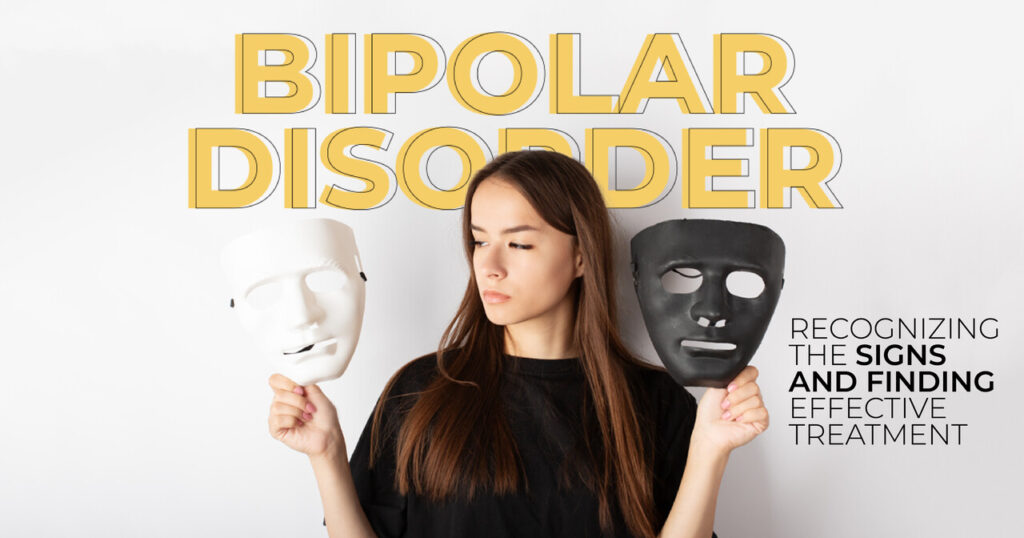Hey there! If you’re reading this, you might be seeking information about bipolar disorder, either for yourself or a loved one. First, thank you for taking this step toward understanding and managing this condition. Bipolar disorder can feel overwhelming, but knowledge is power.
Essential Takeaways
- Recognize the Signs Early: Understanding the symptoms of bipolar disorder and differentiating between manic and depressive episodes can lead to earlier diagnosis and more effective treatment.
- Seek Comprehensive Treatment: Combining medication, psychotherapy, and lifestyle changes offers the best approach to managing bipolar disorder and improving quality of life.
- Utilize Support Systems: Building a solid support network and accessing resources can provide significant assistance in managing bipolar disorder and navigating daily challenges.
By the end of this article, you’ll have a solid grasp of what bipolar disorder is, how to recognize its signs, and what treatment options are available. Let’s dive in and break it all down together!
What is Bipolar Disorder?
Bipolar disorder is a mental health condition characterized by extreme mood swings that include emotional highs (mania or hypomania) and lows (depression). These mood episodes can affect sleep, energy levels, behavior, judgment, and the ability to think clearly. Understanding this mental disorder is crucial for managing it effectively and supporting those living with it.
Shine Mental Health
Understanding Bipolar Disorder
So, what exactly is bipolar disorder? It’s more than just occasional mood swings. It’s a lifelong condition that requires ongoing management. Bipolar disorder is marked by episodes of mania (or hypomania) and depression, which can vary in duration and intensity. These episodes can disrupt daily life, affect relationships, and impact overall well-being.
Types of Bipolar Disorder
- Bipolar I Disorder: Defined by manic episodes that last at least seven days or are severe enough to require immediate hospital care. Depressive episodes may also occur, lasting at least two weeks. It can be severe and may involve psychotic symptoms.
- Bipolar II Disorder: Involves a pattern of depressive episodes and hypomanic episodes, but not the full-blown manic episodes typical of Bipolar I. Hypomania is a milder form of mania and doesn’t include the severe impairment or hospitalization seen in Bipolar I.
- Cyclothymic Disorder (Cyclothymia): Characterized by periods of hypomanic symptoms and periods of depressive symptoms lasting for at least two years (one year in children and adolescents). However, the symptoms do not meet the criteria for a hypomanic episode and a depressive episode.
- Other Specified and Unspecified Bipolar and Related Disorders: Conditions that do not fit into the above categories but still involve bipolar-like symptoms.
Recognizing the Signs and Symptoms
Identifying bipolar disorder can be challenging, especially since it involves a range of symptoms that can vary from person to person. Here’s what to look out for:
Symptoms of Mania and Hypomania
- Mania: Characterized by an extremely elevated mood, excessive energy, and impulsive behavior. Individuals may experience euphoria, irritability, or agitation. They might make risky decisions, such as spending large amounts of money, or engage in reckless behaviors. Other manic symptoms include racing thoughts, rapid speech, poor judgment, and a decreased need for sleep.
- Hypomania: This is a milder form of mania, with similar symptoms but less severe. While a hypomanic episode can still cause noticeable changes in mood and behavior, it usually doesn’t impair daily functioning to the extent seen in mania.
Symptoms of Depression
- Depressed Mood: A constant feeling of sadness or emptiness, often accompanied by feelings of hopelessness and worthlessness.
- Loss of Interest: Lack of interest or pleasure in activities once enjoyed.
- Fatigue: Extreme tiredness and general lack of energy.
- Sleep Changes: Insomnia or excessive sleep.
- Appetite Changes: Significant weight loss or gain.
- Feelings of Guilt: Excessive or inappropriate guilt and feelings of worthlessness.
- Suicidal Thoughts: Increased risk of suicide, including previous attempts.
Mixed Episodes
Sometimes, individuals experience symptoms of both mania and depression simultaneously or in rapid succession. This is referred to as mixed episodes, which can be particularly confusing and distressing.
Causes and Risk Factors
Understanding the underlying causes and risk factors of bipolar disorder can help in managing and treating it effectively.
Genetic Factors
Genetics play a significant role in bipolar disorder. If you have a family history of the disorder, your risk of developing it is higher.
Biological Factors
Research suggests that bipolar disorder involves changes in brain structure and function. Neurotransmitters like serotonin, dopamine, and norepinephrine may contribute to the disorder.
Environmental and Lifestyle Factors
Stressful life events can trigger or exacerbate bipolar disorder. Additionally, alcohol and drug misuse can contribute to the onset or worsening of symptoms.
Diagnosis and Assessment
Getting an accurate diagnosis is crucial for effective treatment.
Diagnostic Criteria
Bipolar disorder is diagnosed based on criteria outlined in the DSM-5 (Diagnostic and Statistical Manual of Mental Disorders, Fifth Edition).
Shine Mental Health
Professional Assessment
A thorough evaluation by a psychiatrist or psychologist is essential. This may include a detailed personal and family history.
Self-Assessment and Monitoring
Keeping track of your mood, energy levels, and behaviors can provide valuable information for your healthcare provider.
Effective Treatment Options
Treating bipolar disorder involves a combination of approaches tailored to the individual’s needs.
Medication
- Mood Stabilizers: Commonly used to manage and stabilize mood swings.
- Antipsychotics: Used to treat manic episodes and, in some cases, depressive episodes.
- Antidepressants: Usually used in conjunction with mood stabilizers.
Electroconvulsive Therapy (ECT)
In severe cases or when other treatments have failed, ECT may be recommended for rapid symptom relief.
Transcranial Magnetic Stimulation (TMS)
This non-invasive procedure can be beneficial for treating bipolar depression.
Psychotherapy
- Cognitive Behavioral Therapy (CBT): Helps individuals identify and change negative thought patterns.
- Interpersonal and Social Rhythm Therapy (IPSRT): Focuses on stabilizing daily routines and improving interpersonal relationships.
- Family-Focused Therapy: Involves educating family members about the disorder.
Lifestyle and Self-Care
- Routine and Structure: Maintaining a regular daily routine helps stabilize mood.
- Healthy Living: Regular exercise, a balanced diet, and adequate sleep contribute to overall well-being.
- Stress Management: Techniques like mindfulness and relaxation exercises can help manage stress.
Living with Bipolar Disorder
Managing bipolar disorder is a lifelong process, but with the right tools and support, individuals can lead fulfilling lives.
Building a Support System
Having a strong support network is crucial, including supportive friends, family members, and mental health professionals.
Workplace and Social Life
Navigating work and social situations can be challenging, but open communication about your needs can help.
Conclusion
Bipolar disorder is a complex and often misunderstood condition that requires compassion, understanding, and comprehensive treatment. Recognizing the signs and seeking help can significantly improve your quality of life.
Shine Mental Health
Call to Action
Feeling inspired to take the next step? Whether it’s seeking treatment, joining a support group, or educating yourself further, your journey toward managing bipolar disorder starts now!
FAQs
- What is the difference between bipolar I and bipolar II disorder?
- Bipolar I involves severe manic episodes and often depressive episodes, while Bipolar II involves hypomanic episodes and depressive episodes. Bipolar I usually has more intense mania.
- How is bipolar disorder diagnosed?
- Bipolar disorder is diagnosed through a comprehensive psychiatric evaluation, including a detailed history of symptoms, family history, and assessment tools based on DSM-5 criteria.
- What are the common treatments for bipolar disorder?
- Treatment typically includes mood stabilizers, antipsychotics, and antidepressants, along with psychotherapy approaches like CBT and IPSRT.
- Can lifestyle changes help manage bipolar disorder?
- Yes, maintaining a structured routine, healthy living, and stress management are important components of managing bipolar disorder alongside medication and therapy.
- Where can I find support if I have bipolar disorder?
Support can be found through mental health professionals, support groups, online communities, and educational resources provided by organizations specializing in mental health.







